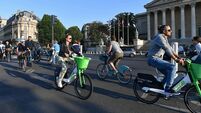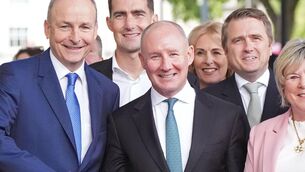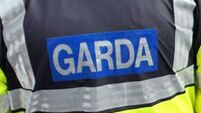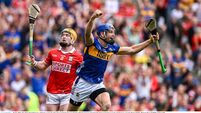Crime in 2016: It was the year of living dangerously

The omens for 2016 were grim from the start.
In mid January, the torso of a dismembered body was found inside a suitcase on a stretch of the Grand Canal in rural Kildare.
The gruesome find shocked the tiny village of Arclough and jolted the nation.
“Macabre and grotesque” was how local Tom McLoughlin described it to the Irish Examiner at the time.
Other parts of the man's body were subsequently discovered.
The victim, who had been shot before dismemberment, was identified as Kenneth O'Brien, a 33-year-old father from Clondalkin, west Dublin.
It was a crime, many thought at the time, that could not be surpassed over the rest of the year.
BITS OF A BODY TO BODIES
But just three weeks later, a gun attack took place that raised the bar in terms of the scale and audaciousness of gangland – all captured by media photographers covering a boxing weigh-in attended by senior members of the feared Kinahan crime cartel.
The images of gunmen, dressed in SWAT-type uniforms, brandishing AK47 military assault rifles in broad daylight about to enter the Regency Hotel was a landmark moment in crime and security in Ireland.
Those images, and video clips from inside the hotel, were beamed across the world.
In Ireland, they had a similar impact on the psyche of the nation as the images of Veronica Guerin's car marooned on the Naas Road after the Gilligan gang shot the journalist dead, again in broad daylight, ten years previously.
The Regency attack not only threatened the security of the state – like the murder of Ms Guerin – but unleashed a murderous feud unprecedented in its intensity.
The decision by members of the Hutch criminal gang to target the Kinahan cartel at the Regency – in revenge for the Kinahan murder of former cartel member Gary Hutch in Spain the previous September - was a major miscalculation on their part.
They succeeded in killing Kinahan lieutenant David Byrne, from Crumlin, south Dublin, but failed to murder Daniel Kinahan, son of Kinahan boss, Christy.
Three days after Regency and amid heavy armed policing, a Kinahan hit team drove into the north inner city, the base of the Hutch gang, and murdered Eddie Hutch Senior - the brother of Gerry “The Monk” Hutch and a taxi driver not involved in the gang.
Days later, the funeral of David Byrne disgusted the nation: dripping with excess, including a fleet of ten limousines, designer clothing, and a remote control toy car that drove down the aisle of the church, all boasting a massive Garda security presence.
Soon after that, the Criminal Assets Bureau seized 35 luxury cars and motorbikes and expensive watches, worth in the region of €1 million from Kinahan leaders in Ireland, based around Crumlin/Drimnagh in south Dublin and the neighbouring south inner city area.
In one of the homes targeted in Crumlin, elite units had to smash through heavily-fortified security, including reinforced gates and front doors.
At the rear of the house they found an indoor bar with 20 bottles of Dom Perignon and sunken bath with a jacuzzi.
The Kinahan murder spree continued, with three murders in a dizzy five-week period between March and April.
One of those killed was a homeless dad, Martin O'Rourke, gunned down in a reckless attack on a Hutch gang figure outside a pub.
Also killed was Michael Barr, a dissident republican, linked to another dissident thought to have been one of the Regency hit team.
The bloodshed did not end there in what gardaí described as a “one-sided war”.
In May, Gareth Hutch, nephew of The Monk, was gunned down outside his home, again in the north inner city.
It brought to four the number of murders in the north inner city since February.
The local community – long accustomed to having to demand that the State protect it – again called for help and investment.
What made the community particularly anxious was that many of the killers were from the local community.
They were either guns for hire (including INLA members) or people who owed money to the Kinahan cartel.
Another murder, of David Douglas, occurred in July and, in August, a second innocent man, Trevor O'Neill, fell victim to the Kinahan cartel when he was shot dead in Spain in a botched attack on a brother of The Monk.
A lull in the bloodshed followed, but more on that anon.
POLICING THE FEUD
During the summer and autumn and into the winter, there were multiple other attacks – either failed or prevented – on the Hutch gang and members of the wider Hutch family.
Garda bosses estimated that they prevented around 12 assassination attempts and also confiscated an arsenal of weapons, including machine guns and AK47s.
With overtime pumped into stretched garda resources, investigators were able to clock up major progress in their inquiries, with multiple arrests and charges.
A Special Crime Task Force was set up to specifically target the mid and lower ranks of the Kinahan cartel and other gangs and laws were changed allowing CAB to seize small quantities of cash and assets.
The Government investment also allowed for ongoing, though not always constant, armed checkpoints and patrols and air support in the north inner city and on the southside.
In September, in what was an unprecedented development, Spanish police took part in planned raids in Dublin aimed at the Kinahan cartel. At the same time gardaí joined Guardia Civil searches in Marbella.
Just days before this operation a leading suspect was arrested in Spain on suspicion of the murder of Gary Hutch.
All the while, gardaí remained on alert with the Drugs & Organised Crime Bureau playing a high profile role in preventing assassination attempts and seizing weapons.
In November, five firearms – including two MP9 submachine guns and three loaded handguns – along with two silencers were seized.
In early December, the Armed Support Unit for Dublin became operational. The 55-strong uniformed squad will provide a permanent 24/7 armed patrol and intervention resource, with a key focus on preventing further feud murders.
It has been actively patrolling the affected areas since amid constant fears of further bloodshed.
With two innocent men already killed by Kinahan gunmen, community leaders fear who will be the next victim of reckless attacks involving high-powered weaponry.

SCANDALS & STRIKES
This was not the only battle An Garda Síochána was fighting this year, with battles raging on other fronts.
The force was being battered by renewed controversies over garda whistleblowers and also by an escalating industrial dispute that only pulled back from the brink well passed the 11th hour.
Commissioner Nóirín O'Sullivan was embroiled in a number of controversies, some of more import that others.
Back in May, the Irish Examiner published transcripts from the opening days of the O'Higgins inquiry (investigating malpractice in Cavan-Monaghan division) in which counsel for the commissioner said he was instructed to challenge the “integrity and motivation” of Sergeant Maurice McCabe.
The commissioner remained tight-lipped on the revelations, saying she could not clarify her instructions as the law surrounding commissions of inquiry prohibited any such disclosure and that she also enjoyed lawyer-client confidentiality.
Matters relating to this controversy were referred, on the suggestion of the commissioner, to the Garda Ombudsman (GSOC).
Allegations were also made by deputies Mick Wallace and Clare Daly about her handling of separate garda whistleblower cases involving Nick Keogh and Keith Harrison.
Then, in early October, came perhaps the most serious crisis to hit her: claims from a new garda whistleblower that she knew about a campaign to destroy Sgt McCabe, involving the spreading of false, scandalous and damaging allegations about Sgt McCabe.
A scoping inquiry, under Mr Justice Iarflaith O'Neill, was set up and has reported to Tánaiste Frances Fitzgerald, who has referred to the Attorney General.
Meanwhile, the GSOC inquiry was back in the news when the Irish Examiner revealed that the watchdog had been unable to progress its inquiry because it was not able to get access to relevant documentation, first from the Commissioner and then from the Department of Justice, which held the O'Higgins Inquiry documentation.
Both cited the law on commissions of investigation, precluding the release of such documentation. The department informed GSOC it would have to get a court order to access it, which it is currently in the process of seeking.
It highlighted yet again the sometimes Kafkaesque world of justice inquiries.
The commissioner was then involved in a further controversy when the Sunday Times reported that she had been using a Gmail account and that a Dropbox account attached to it had been hacked.
The newspaper sparked concerns that emails or dropbox files of a sensitive nature could have been accessed.
This issue is currently being examined by the Policing Authority.
During much of this time, the commissioner was facing the first ever garda strike in the history of the force.
Though she had no input into the financial dispute, she did have a role in devising emergency cover for the intended strikes in November and December.
In what was one of the most intense, and in many ways, surreal, days for policing in the country, the strike was only averted with just hours to go before the first strike day on November 4.
A ballot by the two bodies, the Garda Representative Association and the Association of Garda Sergeants and Inspectors, of a deal hammered out in the Labour Court was overwhelmingly accepted at the beginning of December – providing a collective sigh of relief but causing massive ripple effects for public sector pay.
DISSIDENTS
At around the same time, gun murders were taking place again, after a lull in gangland killings since July.
Notorious Ballyfermot drug dealer Mark Desmond became the twelfth gun murder victim on December 1, when he was shot dead in Lucan, west Dublin.
Seven days later, equally notorious criminal and dissident republican Aidan O'Driscoll was gunned down in broad daylight in Blackpool, Cork city.
He was the second former dissident to be murdered this year, following the assassination of Vincent Ryan (brother of murdered Real IRA leader Alan Ryan) in Finglas back in February.
Though the motives for both murders, particularly that of O'Driscoll, are not clear, they highlight the unpredictable violence inherent within dissident groupings and the blurred line between such outfits and criminal gangs.
Many dissidents are themselves heavily involved in serious criminality, including drug dealing, or in taxing the profits of dealers.
Dissidents groups like the Real IRA, the Continuity IRA and the INLA are riven with splinter groups and semi-autonomous local cells.
The violent pasts of both victims, and long list of enemies they have built up over the years, came back home to roost.
It also brought the grim reality of gangland murders back on to the streets of Cork, where such events are still relatively rare.
As we inched towards Christmas, 62-year-old Noel Kirwan was gunned down in Clondalkin, west Dublin, at tea-time last Thursday.
A criminal from the north inner city, he was well known back in the 1980s and 1990s as a "heavy", involved in protection rackets and robberies.
He was friendly with The Monk since they were children growing up together on the streets.
While investigations are still early, the Kinahan cartel is a leading suspect. It would bring an end to the apparent lull in the Kinahan killing machine if it turns out to be the case.
DEATH TOLL
There have been an estimated 15 gang-related killings in 2016. This includes 14 gangland gun murders.
Seven of those are linked to the Kinahan-Hutch feud (six are Kinahan killings). Mr Kirwan's death would add another to that.
All but the murder of O'Driscoll and Noel Duggan (friend and associate of The Monk) occurred in Dublin.
As of 6 December, there have been 44 arrests in relation to gang-killings, with five people charged in relation to the murders and a further three charged with related offences.
Some 22 firearms have been seized, 8,000 lines of inquiry conducted and more than 11,500 high visibility checkpoints conducted.
It should be remembered that 2016 is not the worst year on record for gangland murders – an honour currently held by 2009, when there were 22 such deaths.
Gang killings were at their height during the mid-to-late 2000s, when they averaged 18 per year.
They dropped to single figures since (bar 2012: 14) and reached a low of three in 2015. This year marks an almost five-fold increase on that.
But the tally for 2016 could be even worse save for the estimated 12 intended murder attempts in the Kinahan-Hutch feud that were prevented by garda operations.
Whether we are returning to the height of gun violence of the 2000s is not clear.
The boosted armed garda units, and the promised continuing recruitment of gardaí, will assist in preventing and responding to armed incidents.
But these measures can't stop the killing – nor on their own provide the massive, long-term intervention needed in communities most affected by gang intimidation and violence.
Burglaries down but murders and sex offences see increase

It has been a mixed year in terms of trends on crime.
This was reflected in two sets of figures produced by the CSO in December.
In the most recent report, the CSO revealed that while high-volume crimes such as burglaries and thefts were down significantly in the last year, murders and sexual offences were up.
Before that, the agency highlighted that while recorded crime in 13 of 16 categories fell between 2010 and 2014 (in some cases dramatically) the crime-solving rate had dropped substantially.
In relation to those most recent figures, covering the year to the end of September 2016, the CSO found that there was a 14% increase in the number of murders, up from 29 (in the year ending September 2015) to 33 in the most recent 12-month period.
This was due in no small part to the Kinahan-Hutch feud, accounting for seven of the murders.
It also took into account an act of unimaginable horror that saw four murders — a woman and her three children — overnight on August 29 in Cavan.
The killer, Alan Hawe, used knives and a hatchet to murder his wife, Clodagh, and their three children, Ryan, 6, Niall, 11, and Liam, 13.
It was an act, gardaí explained, that took considerable time, effort, and will.
The fact that Hawe left a note at his house in Barconey, outside Ballyjamesduff, regarding his actions showed planning and intent.
Hawe took his own life after extinguishing those of his entire family.
It was a crime that shocked the country and led to concerns about the scale and seriousness of domestic violence.
In addition to murders, the Kinahan feud is thought to be behind a 50% increase in attempted murders and a 7% rise in threats of murder.
The CSO figures also found a significant increase in reported sexual offences, drink driving, and drug offences, as well as rises in serious assaults.
But it revealed there were substantial falls in reported burglaries (down 31%) and thefts (down 15%).
Sexual offences rose by 7%, including a 5% increase in rapes and a 9% rise in defilement of a juvenile;
Assaults were down marginally, by 1%, but assaults causing harm (serious assaults) were up 2%;
Dangerous acts were up 5%, including drink driving up 6% and child neglect up 20%;
Robbery was down 11%, including robbery from the person down 10%, and robbery of a bank down 13%, but cash-in-transit raids were up 20%;
Drug offences were up 4%, including a 19% jump in drug importation, drugs supply up 5%, and drug possession, up 3%;
Weapons offences were down 12.5%, including shootings down 22%, gun possession down 6%, and possession of an offensive weapon down 11%;
Public order offences were down 18%.
Separate figures on detection rates show that homicide detection rates dropped from 83% in 1979 to 79% in 2014.
Sexual offences detection rates fell from 65% to 47%, robbery rates decreased from 53% to 40%, while burglary rates dropped from 25% to 18%.
The Irish Examiner understands that these trends have continued into 2015 and 2016.
Garda HQ said factors include the loss of experienced investigators, antiquated technology, and greater forensic awareness among criminals.
It said steps were being taken to redress the problem, including recruitment, training, and investment in technology.
14 gangland gun killings 2016
Kenneth O’Brien, 33, from Lealand Rd, Clondalkin. Shot and then dismembered, with remains found along the Grand Canal, including his torso at Ardclough, Co Kildare. Man charged.
David Byrne, 34, from Crumlin, south Dublin, and senior Kinahan lieutenant, shot dead at Regency Hotel, north Dublin. Man charged.
Eddie Hutch Sr, 59, shot dead at his home on Poplar Rd, Ballybough, Dublin’s north inner city, by Kinahan cartel. No charges pressed yet.
Dissident republican Vincent Ryan, 25 and dad of newborn, shot dead outside partner’s home on McKee Rd, Finglas, north Dublin. No charges yet.
Noel Duggan, 56, criminal and friend and associate of Gerry ‘The Monk’ Hutch, shot dead at his home in Ratoath, Co Meath, by Kinahan cartel. No charges yet.
Martin O’Rourke, 24, innocent homeless man shot dead on Sheriff St Lower, Dublin’s north inner city, as Kinahan gunman recklessly fired at his target, a Hutch gang member. No charges yet.
Michael Barr, 35, dissident republican, shot dead in Sunset House Pub on North Strand, Dublin’s north inner city. Man charged.
Tom Farnan, 37, shot at his home, Kilcronan Close, Clondalkin, west Dublin. The dad-of-two was originally from Brookfield, Tallaght. No charges yet.
Gareth Hutch, 35 and a dad, shot dead in car park of Avondale House flats complex on Cumberland Rd, Dublin’s north inner city. Two men charged.
Neil Fitzgerald, 36, found shot dead in rural area near Tallaght, south west Dublin. Had only been released from prison two weeks previously. Senior member of Rattigan crime gang. No charges yet.
David ‘Daithí’ Douglas, 53, from Cabra, north Dublin, shot dead on Bridgefoot St in Dublin’s south inner city. Man charged.
Mark Desmond, 41, from Ballyfermot, west Dublin, shot dead at Griffeen Valley Park in Lucan, west Dublin, in suspected drug row. No charges yet.
Aidan O’Driscoll, 37, from Ballyvolane, Cork City, a former Real IRA leader, was shot dead on the street in the Blackpool area. No charges yet.
Noel ‘Duck Egg’ Kirwan was shot at least four times while in his car outside his home in Ronanstown, west Dublin. No charges yet.












